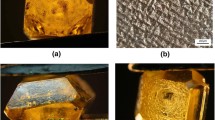Abstract
Diamond crystals with low nitrogen concentration were synthesized from the Fe-Ni-C system with Ti additive at high pressure and high temperature (HPHT) in a china-type cubic high pressure apparatus (CHPA). The synthesis pressure range was 4.8–5.2 GPa, and the temperature range was 1420–1600 K. The lowest synthesis pressure for diamond fell first and then rose with the increase of Ti additive. The color, shape, surface morphology and nitrogen impurity concentration of the synthesized diamond crystals were characterized using optical microscopy (OM), scanning electron microscopy (SEM) and micro Fourier transform infrared (FTIR) spectrometry. The results show that the Ti additive has significant effects on color, growth rate, crystal shape, surface morphology and nitrogen impurity concentration of the synthesized diamond crystals. The color of diamond crystals synthesized without Ti additive is yellow, while that with Ti additive becomes light and nearly colorless. The growth rate without Ti additive is higher than that with Ti additive. The crystal shapes of as-grown diamond crystals vary with the increase of Ti additive. The {111} crystal faces become dominant and some {311} crystal faces appear with the increase of Ti additive. The concentration of nitrogen impurity in diamond crystals without Ti additive is higher than that with Ti additive.
Similar content being viewed by others
References
Bundy F P, Hall H T, Strong H M, et al. Diamond facets. Nature, 1955, 176: 51–55
Ekimov E A, Sidorov V A, Bauer E D, et al. Superconductivity in diamond. Nature, 2004, 428: 542–545
Kanda H, Akaishi M, Yamaoka S. Synthesis of diamond with the highest nitrogen concentration. Diamond Relat Mater, 1999, 8: 1441–1443
Borzdov Y, Pal’yanov Y, Kupriyanov I, et al. HPHT synthesis of diamond with high nitrogen content from an Fe3N-C system. Diamond Relat Mater, 2002, 11: 1863–1870
Kindlein Jr W, Livi R P, Balzaretti N M, et al. Effect of hydrogen implantation on the graphite used in high pressure diamond synthesis. Diamond Relat Mater, 2000, 9: 22–25
Kaiser W, Bond W L. Nitrogen, a major impurity in common type I diamond. Phys Rev, 1959, 115: 857–863
Kiflawi I, Kanda H, Lawson S C. The effect of the growth rate on the concentration of nitrogen and transition metal impurities in HPHT synthetic diamonds. Diamond Relat Mater, 2002, 11: 204–211
Kanda H, Watanabe K. Distribution of nickel related luminescence centers in HPHT diamond. Diamond Relat Mater, 1999, 8–9: 1463–1469
Kalish R. Doping of diamond. Carbon, 1999, 37: 781–785
Reinitz I M, Fritsch E, Shigley J E. An oscillating visible light optical center in some natural green to yellow diamonds. Diamond Relat Mater, 1998, 7: 313–316
Collins A T, Kanda H, Kitawaki H. Colour changes produced in natural brown diamonds by high-pressure, high-temperature treatment. Diamond Relat Mater, 2000, 9: 113–122
Sumiya H, Toda N, Satoh S. Growth rate of high-quality large diamond crystals. J Crystal Growth, 2002, 237–239: 1281–1285
Ma H A, Jia X P, Zhang G, et al. High-pressure pyrolysis study of C3N6H6: A route to preparing bulk C3N4. J Phys: Cond Matter, 2002, 14: 11269–11273
Li L, Xu B, Li M S. Analysis of the carbon source for diamond crystal growth. Chinese Sci Bull, 2008, 53: 937–942
Xu B, Li M S, Yin L W, et al. Microstructures of metallic film and diamond growth from Fe-Ni-C system. Chinese Sci Bull, 2002, 47: 1258–1262
Yang Z J, Li H Z, Peng M S, et al. Study on the HPHT synthetic diamond crystal from Fe-C(H) system and its significance. Chinese Sci Bull, 2008, 53: 137–144
Strong H M, Chrenko R M. Diamond growth rates and physical properties of laboratory-made diamond. J Phys Chem, 1971, 75: 1838–1843
Sumiya H, Satoh S. High-pressure synthesis of high-purity diamond crystal. Diamond Relat Mater, 1996, 5: 1359–1365
Li S S, Jia X P, Zang C Y, et al. Effects of Al and Ti/Cu on synthesis of type-IIa diamond crystals in Ni70Mn25Co5-C system at HPHT. Chin Phys Lett, 2008, 25: 3801–3804
Sumiya H, Satoh S. Synthesis of polycrystalline diamond with new non-metallic catalyst under high pressure and high temperature. Int J Refract Met Hard Mater, 1999, 17: 345–350
Kiflawi I, Mayer A E, Spear P M, et al. Infrared absorption by the single nitrogen and a defect centres in dianond. Philos Mag B, 1994, 69: 1141–1147
Author information
Authors and Affiliations
Corresponding author
Additional information
Supported by the National Natural Science Foundation of China (Grant Nos. 50572032 and 50731006)
About this article
Cite this article
Han, W., Jia, X., Jia, H. et al. Effects of Ti additive on HPHT diamond synthesis in Fe-Ni-C system. Chin. Sci. Bull. 54, 2978–2981 (2009). https://doi.org/10.1007/s11434-009-0362-5
Received:
Accepted:
Published:
Issue Date:
DOI: https://doi.org/10.1007/s11434-009-0362-5




